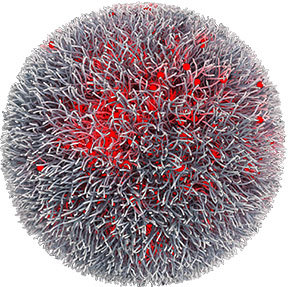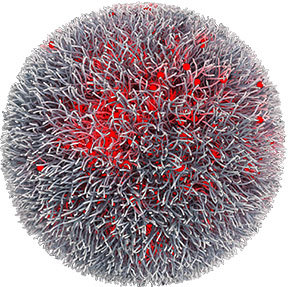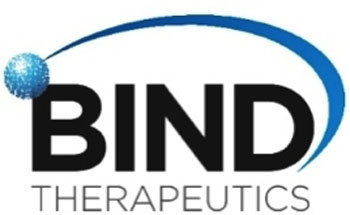CAMBRIDGE, Mass.--(BUSINESS WIRE)--BIND Therapeutics, Inc. (NASDAQ: BIND), a clinical-stage nanomedicine company developing innovative therapeutics called ACCURINS®, today announced the publication of data highlighting the ability of ACCURIN polymeric nanoparticle technology to utilize hydrophobic ion pairing and improve the therapeutic index of a molecularly targeted anti-cancer drug. Previous efforts with nanotechnology have focused almost exclusively on encapsulating chemotherapy payloads; the publication describes one of the first efforts to apply nanotechnology to a molecular targeted agent. Results highlight the potential for ACCURINS® to control release kinetics and provide increased concentration of an aurora B kinase inhibitor, AZD2811, at tumor sites resulting in prolonged pharmacodynamic effects, superior tumor growth inhibition and a reduction in on-target but off-tissue toxicity. These data were published in the February 10, 2016 issue of Science Translational Medicine.
“These data demonstrate the potential to extend the benefits of our ACCURIN platform beyond chemotherapy payloads to kinase inhibitors, which are a rapidly growing component of the armamentarium against cancer,” said Jonathan Yingling, Ph.D., chief scientific officer at BIND Therapeutics. “The data in this publication illustrate that ACCURINS® are able to entrap and control the release rate of payloads with wide ranging physicochemical properties, including molecules with ionizable functional groups, which enables our platform to generate more novel and innovative medicines beyond targeted chemotherapies. There are multiple oncogenic pathways that have proven difficult to target with conventional approaches and that we believe the targeted and modular nature of ACCURIN nanomedicines are well suited to address.”
In the paper entitled, "Aurora kinase inhibitor nanoparticles target tumors with favorable therapeutic index in vivo," researchers demonstrated the accumulation and retention of a specific AZD2811 nanoparticle formulation in tumors, resulting in an extended reduction of tumor phosphorylated histone H3 levels in vivo for up to 96 hours following a single administration with minimal impact on bone marrow pathology. This formulation also demonstrated continuous drug release for more than one week in vitro, and displayed lower toxicity and increased efficacy in multiple tumor models at half the dose intensity of a water-soluble prodrug of AZD2811. These preclinical studies using ion pairing agents with AZD2811 and ACCURIN technology suggested improved tolerability as well as less frequent dosing.
"Data from this paper support the recent initiation of the phase 1 trial with AZD2811, the first nanoparticle that encapsulates a molecularly targeted drug to enter the clinic," said Andrew Hirsch, BIND's president and chief executive officer. “The novel patented hydrophobic ion pairing approach that we developed partially through our collaboration with AstraZeneca demonstrates an important benefit of our collaboration strategy. This new approach has significantly expanded the number of payloads that are compatible with our ACCURIN platform and is enabling us to explore new applications of our ACCURIN technology such as extra-hepatic delivery of oligonucleotide-based therapeutics, targeted antibiotics, and novel immuno-oncology approaches.”
About BIND Therapeutics
BIND Therapeutics is a
clinical-stage nanomedicine company developing a pipeline of ACCURINS®,
its novel targeted therapeutics designed to increase the concentration
and duration of therapeutic payloads at disease sites while reducing
exposure to healthy tissue. BIND is leveraging its Medicinal
Nanoengineering® platform to develop a pipeline of ACCURINS®
targeting hematological and solid tumors and has a number of strategic
collaborations with biopharmaceutical companies to develop ACCURINS®
in areas of high unmet need. BIND's lead drug candidate, BIND-014, is a
prostate-specific membrane antigen (PSMA) -targeted ACCURIN that
contains docetaxel, a clinically-validated and widely-used cancer
chemotherapy drug. BIND is currently evaluating BIND-014 in the phase 2
iNSITE 1 trial for non-small cell lung cancer, or NSCLC, with squamous
histology. In addition, BIND is enrolling patients in the iNSITE 2
clinical trial with BIND-014 for advanced cancers of the cervix and head
and neck. BIND is advancing BIND-510, its second PSMA-targeted ACCURIN
drug candidate containing vincristine through important preclinical
gating studies to potentially position it for an Investigational New
Drug (IND) application filing with the U.S. Food and Drug
Administration. BIND is also developing ACCURINS® designed to
inhibit PLK1 and KSP, both of which BIND believes are promising
anti-mitotic targets that have been limited in the clinic due to
systemic toxicity at or below their therapeutic doses.
BIND has announced ongoing collaborations with Pfizer Inc., AstraZeneca AB, F. Hoffmann-La Roche Ltd., Merck & Co., or Merck (known as Merck Sharp & Dohme outside the United States and Canada) and Macrophage Therapeutics (a subsidiary of Navidea Biopharmaceuticals) to develop ACCURINS® based on their proprietary therapeutic payloads and/or targeting ligands. BIND's collaboration with AstraZeneca has resulted in the Aurora B Kinase inhibitor ACCURIN AZD2811, which became the second ACCURIN candidate to enter clinical development. BIND's collaboration with Pfizer has resulted in the selection of an ACCURIN candidate that is entering IND-enabling studies.
For more information, please visit the Company's web site at www.bindtherapeutics.com.
Forward-Looking Statements Disclaimer
This press release
contains forward-looking statements within the meaning of the Private
Securities Litigation Reform Act of 1995. All statements contained in
this press release that do not relate to matters of historical fact
should be considered forward-looking statements, including without
limitation statements regarding the potential of ACCURINS® to
control release kinetics and provide increased concentration of AZD2811
at tumor sites, and potential effects of this process; the potential to
leverage the benefits of our ACCURIN platform; the ability of ACCURINS®
to address oncogenic pathways; expectations regarding the expansion of
payloads that are compatible with our ACCURIN platform; expectations
regarding BIND-510, including without limitation the filing of an IND
application with the U.S. Food and Drug Administration; and expectations
regarding our collaborations with Pfizer, AstraZeneca, F. Hoffmann-La
Roche Ltd., Merck and Macrophage.
These forward-looking statements are based on management's current expectations. These statements are neither promises nor guarantees, but involve known and unknown risks, uncertainties and other important factors that may cause our actual results, performance or achievements to be materially different from any future results, performance or achievements expressed or implied by the forward-looking statements, including, but not limited to, the following: the fact that the Company has incurred significant losses since its inception and expects to incur losses for the foreseeable future; the Company's need for additional funding, which may not be available; raising additional capital may cause dilution to its stockholders, restrict its operations or require it to relinquish rights to its technologies or drug candidates; the Company's limited operating history; the terms of the Company's credit facility place restrictions on its operating and financial flexibility; failure to use and expand its medicinal nanoengineering platform to build a pipeline of drug candidates and develop marketable drugs; the early stage of the Company's development efforts with only BIND-014 and ACCURIN AZD2811 in clinical development; failure of the Company or its collaborators to successfully develop and commercialize drug candidates; clinical drug development involves a lengthy and expensive process, with an uncertain outcome; delays or difficulties in the enrollment of patients in clinical trials; serious adverse or unacceptable side effects or limited efficacy observed during the development of the Company's drug candidates; inability to maintain any of the Company's collaborations, or the failure of these collaborations; the Company's reliance on third parties to conduct its clinical trials and manufacture its drug candidates; the Company's inability to obtain required regulatory approvals; any conclusion by the FDA that BIND-014 does not satisfy the requirements for approval under the Section 505(b)(2) regulatory approval pathway; the fact that a fast track or breakthrough therapy designation by the FDA for the Company's drug candidates may not actually lead to a faster development or regulatory review or approval process; the inability to obtain orphan drug exclusivity for drug candidates; failure to obtain marketing approval in international jurisdictions; any post-marketing restrictions or withdrawals from the market; effects of recently enacted and future legislation; failure to comply with environmental, health and safety laws and regulations; failure to achieve market acceptance by physicians, patients, or third-party payors; failure to establish effective sales, marketing and distribution capabilities or enter into agreements with third parties with such capabilities; effects of substantial competition; unfavorable pricing regulations, third-party reimbursement practices or healthcare reform initiatives; product liability lawsuits; failure to retain key executives and attract, retain and motivate qualified personnel; difficulties in managing the Company's growth; risks associated with operating internationally, including the possibility of sanctions with respect to our operations in Russia; the possibility of system failures or security breaches; failure to obtain and maintain patent protection for or otherwise protect our technology and products; effects of patent or other intellectual property lawsuits; the price of our common stock may be volatile and fluctuate substantially; significant costs and required management time as a result of operating as a public company; and any securities class action litigation. These and other important factors discussed under the caption "Risk Factors" in our Quarterly Report on Form 10-Q filed with the Securities and Exchange Commission, or SEC, on November 2, 2015, and our other reports filed with the SEC could cause actual results to differ materially from those indicated by the forward-looking statements made in this press release. Any such forward-looking statements represent management's estimates as of the date of this press release. While we may elect to update such forward-looking statements at some point in the future, we disclaim any obligation to do so, even if subsequent events cause our views to change. These forward-looking statements should not be relied upon as representing our views as of any date subsequent to the date of this press release.




